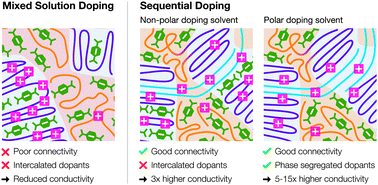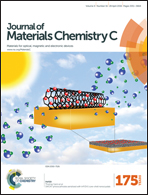Comparison of solution-mixed and sequentially processed P3HT:F4TCNQ films: effect of doping-induced aggregation on film morphology†
Abstract
Doping polymeric semiconductors often drastically reduces the solubility of the polymer, leading to difficulties in processing doped films. Here, we compare optical, electrical, and morphological properties of P3HT films doped with F4TCNQ, both from mixed solutions and using sequential solution processing with orthogonal solvents. We demonstrate that sequential doping occurs rapidly (<1 s), and that the film doping level can be precisely controlled by varying the concentration of the doping solution. Furthermore, the choice of sequential doping solvent controls whether dopant anions are included or excluded from polymer crystallites. Atomic force microscopy (AFM) reveals that sequential doping produces significantly more uniform films on the nanoscale than the mixed-solution method. In addition, we show that mixed-solution doping induces the formation of aggregates even at low doping levels, resulting in drastic changes to film morphology. Sequentially coated films show 3–15 times higher conductivities at a given doping level than solution-doped films, with sequentially doped films processed to exclude dopant anions from polymer crystallites showing the highest conductivities. We propose a mechanism for doping induced aggregation in which the shift of the polymer HOMO level upon aggregation couples ionization and solvation energies. To show that the methodology is widely applicable, we demonstrate that several different polymer:dopant systems can be prepared by sequential doping.


 Please wait while we load your content...
Please wait while we load your content...